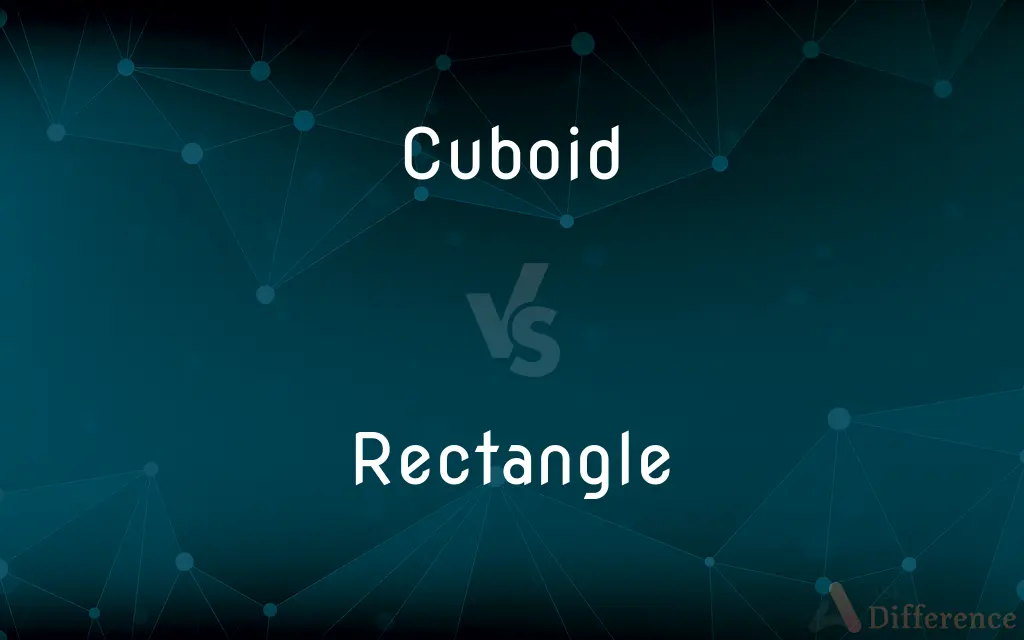Cuboid vs. Rectangle — What's the Difference?
By Maham Liaqat & Urooj Arif — Updated on March 27, 2024
A cuboid is a 3D figure bounded by six rectangles, while a rectangle is a 2D shape with four right angles.

Difference Between Cuboid and Rectangle
Table of Contents
ADVERTISEMENT
Key Differences
Cuboids are three-dimensional structures characterized by six faces, all of which are rectangles, implying depth, width, and height dimensions. On the other hand, a rectangle is a two-dimensional shape, featuring only length and width, with all internal angles at 90 degrees.
While cuboids possess vertices and edges, forming the skeleton of its 3D form, rectangles are defined by their four sides and four vertices, lacking the third dimension present in cuboids.
Cuboids can be considered as stretched or extruded rectangles into the third dimension, providing volume and space. Whereas, rectangles lay flat on a plane, encompassing area but not volume.
In terms of geometry, cuboids have additional properties such as surface area and volume, which are relevant to their three-dimensional nature. Conversely, rectangles are primarily concerned with perimeter and area calculations, reflecting their planar characteristics.
Cuboids offer more complexity in mathematical problems due to their three-dimensional aspects, such as calculating the diagonal across space. Rectangles, however, simplify to calculations involving length and width, including finding the diagonal within the plane.
ADVERTISEMENT
Comparison Chart
Dimensions
3 (length, width, height)
2 (length, width)
Faces/Edges
6 faces, 12 edges
N/A
Vertices
8
4
Volume/Surface Area
Volume and surface area calculable
Only area can be calculated
Diagonal
Diagonals across its faces and through space
Diagonal across the plane
Compare with Definitions
Cuboid
A 3D shape with six rectangular faces.
A dice is a perfect example of a cuboid.
Rectangle
A 2D shape with four right angles.
The screen of a smartphone is usually shaped like a rectangle.
Cuboid
Defined by length, width, and height.
The dimensions of a cuboid are given in terms of its length, width, and height.
Rectangle
Has no volume.
Being a flat shape, a rectangle does not have volume.
Cuboid
Has volume and surface area.
The volume of a cuboid is calculated as length × width × height.
Rectangle
Defined by length and width.
The area of a rectangle is calculated as length × width.
Cuboid
Found in everyday objects.
Many boxes are cuboids due to their sturdy shape and volume.
Rectangle
Common in geometry problems.
Rectangles are often used to teach basic geometry concepts like area and perimeter.
Cuboid
Characterized by having 8 vertices and 12 edges.
Each corner of a cuboid is formed where three edges meet.
Rectangle
Characterized by having 4 vertices and 4 edges.
Each corner of a rectangle is formed where two edges meet at a right angle.
Cuboid
In geometry, a cuboid is a convex polyhedron bounded by six quadrilateral faces, whose polyhedral graph is the same as that of a cube. While mathematical literature refers to any such polyhedron as a cuboid, other sources use "cuboid" to refer to a shape of this type in which each of the faces is a rectangle (and so each pair of adjacent faces meets in a right angle); this more restrictive type of cuboid is also known as a rectangular cuboid, right cuboid, rectangular box, rectangular hexahedron, right rectangular prism, or rectangular parallelepiped.
Rectangle
In Euclidean plane geometry, a rectangle is a quadrilateral with four right angles. It can also be defined as: an equiangular quadrilateral, since equiangular means that all of its angles are equal (360°/4 = 90°); or a parallelogram containing a right angle.
Cuboid
Having the approximate shape of a cube.
Rectangle
A plane figure with four straight sides and four right angles, especially one with unequal adjacent sides, in contrast to a square.
Cuboid
(Anatomy) A tarsal bone on the outer side of the foot in front of the calcaneus and behind the fourth and fifth metatarsal bones.
Rectangle
A four-sided plane figure with four right angles.
Cuboid
(Mathematics) A rectangular parallelepiped.
Rectangle
(geometry) Any quadrilateral having opposing sides parallel and four right angles.
Cuboid
Of the shape of a cube.
Rectangle
(nontechnical) Such a quadrilateral that is oblong (longer than it is wide): one that is not regular (equilateral), that is, any except a square.
Cuboid
(anatomy) The cuboid bone.
Rectangle
A four-sided figure having only right angles; a right-angled parallelogram.
Cuboid
(geometry) A parallelepiped having six rectangular faces.
Rectangle
Rectangular.
Cuboid
Cube-shaped, or nearly so; as, the cuboid bone of the foot.
Rectangle
A parallelogram with four right angles
Cuboid
A rectangular parallelepiped
Cuboid
Shaped like a cube
Common Curiosities
How is a rectangle defined?
A rectangle is a two-dimensional shape with four sides where each internal angle is 90 degrees.
What defines a cuboid?
A cuboid is defined as a three-dimensional shape with six rectangular faces, eight vertices, and 12 edges.
What is the volume of a cuboid?
The volume of a cuboid is calculated as length × width × height.
Can a square be considered a rectangle?
Yes, a square is a special type of rectangle where all sides are equal.
How do you calculate the area of a rectangle?
The area of a rectangle is found by multiplying its length by its width.
Can a cuboid have square faces?
Yes, if the length and width of some or all faces are equal, those faces are squares.
Are all faces of a cuboid rectangles?
Yes, all six faces of a cuboid are rectangles.
Is it possible for a cuboid to be a cube?
Yes, a cuboid becomes a cube when all its lengths, widths, and heights are equal.
How many edges does a rectangle have?
A rectangle has four edges.
What is the surface area of a cuboid?
The surface area of a cuboid is calculated by summing the areas of all its six rectangular faces.
How many vertices does a rectangle have?
A rectangle has four vertices.
What is the difference in dimensions between a cuboid and a rectangle?
A cuboid has three dimensions (length, width, height), while a rectangle has two (length, width).
Why are cuboids and rectangles important in geometry?
They are fundamental in teaching spatial reasoning, geometry concepts, and in applications requiring volume and area calculations.
Can rectangles form the faces of other 3D shapes besides cuboids?
Yes, rectangles can also form faces of other polyhedra, but in a cuboid, all faces are rectangles.
What is the difference between the diagonal of a cuboid and a rectangle?
The diagonal of a cuboid is measured through three-dimensional space, while that of a rectangle is confined to a plane.
Share Your Discovery

Previous Comparison
Hearty vs. Sailor
Next Comparison
Tumbleweed vs. SagebrushAuthor Spotlight
Written by
Maham LiaqatCo-written by
Urooj ArifUrooj is a skilled content writer at Ask Difference, known for her exceptional ability to simplify complex topics into engaging and informative content. With a passion for research and a flair for clear, concise writing, she consistently delivers articles that resonate with our diverse audience.
















































